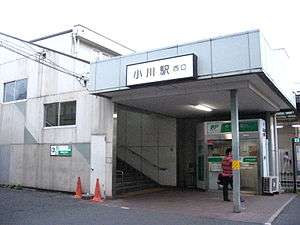Ogawa Station (Tokyo)
Ogawa Station (小川駅, Ogawa-eki) is a railway station in Kodaira, Tokyo, Japan, operated by the private railway operator Seibu Railway.
SS31 SK04 Ogawa Station 小川駅 | |
|---|---|
 West entrance, August 2009 | |
| Location | 1-20-1 Ogawahigashi-chō, Kodaira-shi, Tokyo (東京都小平市小川東町1-20-1) Japan |
| Operated by | |
| Line(s) | |
| Platforms | 2 island platforms |
| Connections |
|
| Other information | |
| Station code | SS31/SK04 |
| History | |
| Opened | 1894 |
| Traffic | |
| Passengers (FY2014) | 28,427 daily |
Lines
Ogawa Station is served by the Seibu Kokubunji Line from Higashi-Murayama to Kokubunji, and by the Seibu Haijima Line from Kodaira to Haijima. It is located 2.7 km from the starting point of the Kokubunji Line at Higashi-Murayama, and 2.8 km from the start of the Haijima Line at Kodaira.[1]
Station layout
The station consists of two ground-level island platforms serving four tracks.[2] The station building is located above the platforms, with entrances on the east and west sides.
Platforms
| 1 | ■ Seibu Haijima Line | for Kodaira and Seibu-Shinjuku |
| 2 | ■ Seibu Kokubunji Line | for Higashi-Murayama and Hon-Kawagoe |
| 3 | ■ Seibu Kokubunji Line | for Kokubunji |
| 4 | ■ Seibu Haijima Line | for Haijima |
Adjacent stations
| « | Service | » | ||
|---|---|---|---|---|
| Seibu Haijima Line | ||||
| Hagiyama | Express | Higashi-Yamatoshi | ||
| Hagiyama | Semi express | Higashi-Yamatoshi | ||
| Hagiyama | Local | Higashi-Yamatoshi | ||
| Seibu Kokubunji Line | ||||
| Takanodai | Local | Higashi-Murayama | ||
History
Ogawa Station opened on 21 December 1894.[1]
Station numbering was introduced on all Seibu Railway lines during fiscal 2012, with Ogawa Station becoming "SS31" on the Haijima Line and "SK04" on the Kokubunji Line.[3]
Passenger statistics
In fiscal 2014, the station was the 34th busiest on the Seibu network with an average of 28,427 passengers daily.[4]
The passenger figures for previous years are as shown below.
| Fiscal year | Daily average |
|---|---|
| 2010 | 28,377[5] |
| 2011 | 28,300[6] |
| 2012 | 28,550[7] |
| 2013 | 29,124.[8] |
Surrounding area
- Polytechnic University
References
- Terada, Hirokazu (19 January 2013). データブック日本の私鉄 [Databook: Japan's Private Railways]. Japan: Neko Publishing. p. 227. ISBN 978-4-7770-1336-4.
- Kawashima, Ryozo (February 2011). 日本の鉄道 中部ライン 全線・全駅・全配線 第11巻 埼玉南部・東京多摩北部 [Railways of Japan - Chubu Line - Lines/Stations/Track plans - Vol 11 Southern Saitama and Northern Tama Tokyo]. Japan: Kodansha. pp. 13–89. ISBN 978-4-06-270071-9.
- 西武線全駅で駅ナンバリングを導入します [Station numbering to be introduced at all Seibu stations] (PDF). News Release (in Japanese). Japan: Seibu Railway. 23 February 2012. Archived from the original (PDF) on 24 September 2015. Retrieved 17 November 2013.
- 駅別乗降人員 2014(平成26)年度 1日平均 [Average daily station usage figures (fiscal 2014)] (PDF) (in Japanese). Japan: Seibu Railway. Archived from the original (PDF) on 8 March 2016. Retrieved 17 May 2016.
- 駅別乗降人員 2010(平成22)年度 1日平均 [Average daily station usage figures (fiscal 2010)] (PDF) (in Japanese). Japan: Seibu Railway. Archived from the original (PDF) on 26 June 2011. Retrieved 17 November 2013.
- 駅別乗降人員 2011(平成23)年度 1日平均 [Average daily station usage figures (fiscal 2011)] (PDF) (in Japanese). Japan: Seibu Railway. Archived from the original (PDF) on 1 November 2012. Retrieved 17 November 2013.
- 駅別乗降人員 (2012年度1日平均) [Average daily station usage figures (fiscal 2012)] (PDF) (in Japanese). Japan: Seibu Railway. Archived from the original (PDF) on 10 September 2013. Retrieved 17 November 2013.
- 駅別乗降人員 (2013年度1日平均) [Average daily station usage figures (fiscal 2013)] (PDF) (in Japanese). Japan: Seibu Railway. Archived from the original (PDF) on 14 July 2014. Retrieved 18 August 2014.
External links
| Wikimedia Commons has media related to Ogawa Station (Tokyo). |
- Seibu station information (in Japanese)